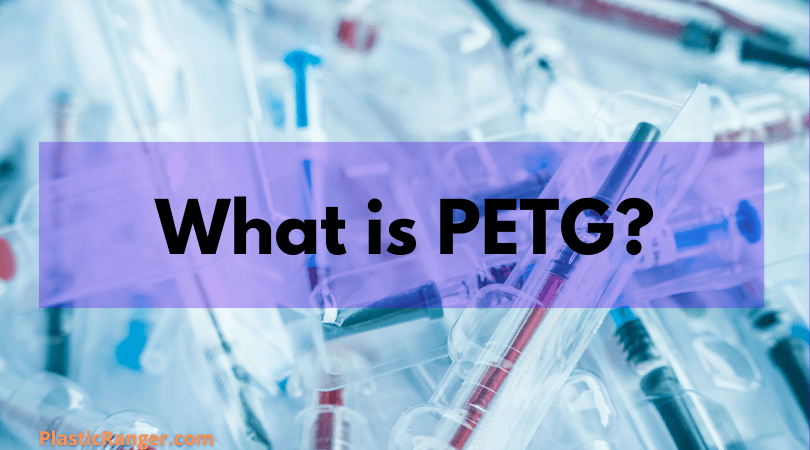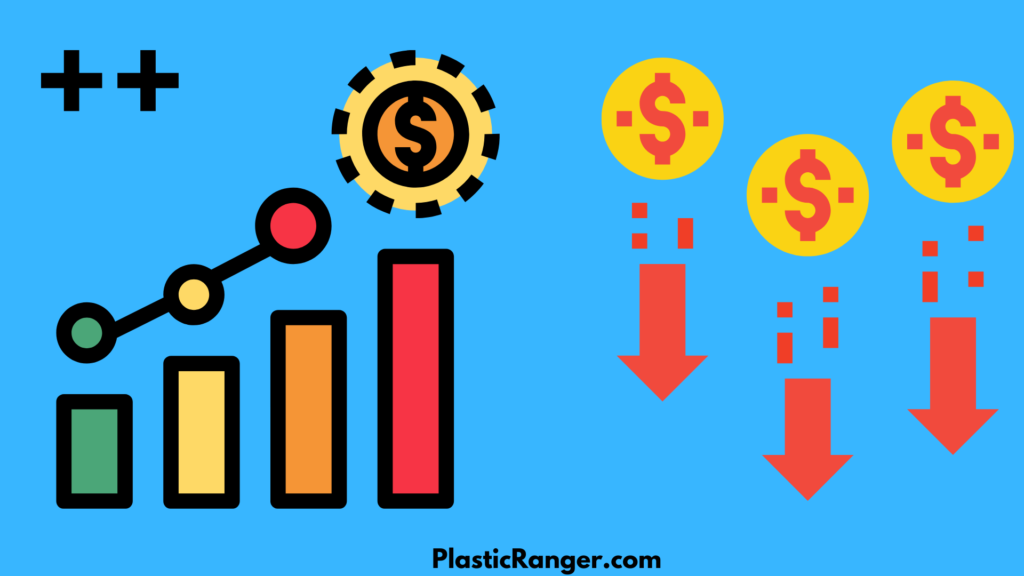What is PETG Plastic?
PETG, also known as polyethylene terephthalate glycol, is a clear copolymer and thermoplastic with excellent durability, chemical resistance, and moldability. It’s a more profound variation of PET (Polyethylene terephthalate) with low-molding temperatures making it easy to mold, heat-bent, and vacuum-formed into various shapes.
Low-molding temperature also makes PETG highly compatible with applications requiring deep cuts, die cuts, and precise molding.
It also has good bonding properties with solvents or adhesives. The handy properties make PETG plastic suitable for manufacturing techniques like bending, drilling, thermoforming, die-cutting, 3D printing, routing, and other heat-forming fabricating methods.
How is PETG Made?
PETG is an advancement from the original polymer called PET. To create the successor, ethylene glycol in the molecular chain with a larger monomer will blend with cyclohexane dimethanol, which will play a key role in stopping the crystallization with PET.
It is produced utilizing a two-step melt-phase polycondensation process. It’s a simple but effective process combining two monomers with the help of a small release of water.
PETG boasts better heat resistance than PET, which helps lower the melting point and inhibits crystallization.
Key Properties of PETG
- As polyethylene terephthalate glycol is a copolymer, it possesses properties of PET and glycol. The blend also reduces the overheating issues quite prevalent in PET.
- It doesn’t require drying before processing in thermoforming and has a fast thermoforming cycle – brake formable up to 0.080″ thickness.
- Excellent impact resistance, on par with mainstream thermoplastics, and less brittle than acrylic. Cost-effective compared with polycarbonate and polyethylene.
- Fantastic chemical resistance on par with other thermoplastics
- Requires a heating plate to avoid warping in ABS 3D printing.
- More susceptible to scratches than PLA.
- Poor moisture resistance is advisable to keep it dry and cool.
- Good thermal stability with easy extrusion.
- The glass transition temp of PETG is 85°C which makes it boast robust chemical properties.
- It can be easily processed in Injection Molding and 3D printing.
Engaging Read – Plastics Vs. Polymers | What are the Differences?
Below is the table with properties and the respective values:
| Property | Metric | Value |
| General Properties | ||
| Density | 0.0455 – 0.0462 | lb/in^3 |
| Tensile Strength | 8.7 – 9.57 | KSI |
| Yield Strength | 6.95 – 7.67 | KSI |
| Elongation | 102 – 115 | % strain |
| Impact Strength | 90.4 – 95.2 | ft.lbf/in^2 |
| Young’s Modulus | 0.292 – 0.306 | 10^6 psi |
| Fracture Strength | 1.92 – 2.31 | KSI/in^0.5 |
| Impact Strength | 90.4 – 95.4 | ft.lbf/in^2 |
| Hardness | 14.4 – 15.9 | HV |
| Thermal Properties | ||
| Melting Point | 81 – 91 | °C |
| Specific Heat Capability | 0.352 – 0.366 | BTU/lb. °F |
| Max Service Temperature | 51 – 65 | °C |
| Insulation | Yes | – |
| Thermal Expansion Coefficient | 66.8 – 68.1 | µstrain/°F |
Advantages & Disadvantages
Advantages
- Food Safe and Recyclable: PETG filament is safe to use in food containers and beverage bottles. It is also fully recyclable, significantly reducing the adverse effects on the environment and increasing its chances of adoption, as environmental safety is one of the top priorities.
- Easy Coloring: PETG plastic is easily colorable to achieve the desired appearance. It is also naturally transparent, which improves its overall applications.
- Strong as well as cost-effective: PETG’s strength and excellent impact resistance make it ideal for glazing applications and high-end displays. That quality also suits it for 3D printing applications like rapid prototypes and signages.
- Meagre Damaging: polyethylene terephthalate glycol provides excellent damage resistance that can even compete with polycarbonate, a more popular and mainstream material; however, It is also smooth and easy to fabricate, making it ideal for both practitioners and professionals.
- Non-Toxic and Odorless: It’s non-toxic and almost odor-free, making it more comfortable to process in any location.
Disadvantages
- No Inaccuracies with Parameters: Accurate parameters are necessary with every thermoplastic, but for PETG, the necessity moves one notch. While 3D printing PETG, it is advised to use the correct temperatures. Following the attributes set by the material manufacturer and supplier would be the best option. Typically a cold base is used with temperatures – 210-260 ºC extruder and 60-80 ºC base. For achieving optimum results with 3D printing, a slow printing speed is recommended (30 – 35 mm/s)
- Susceptible to Oozing: Polyethylene terephthalate glycol is more sensitive to oozing than ABS or PLA. That means it can create some inefficiencies in 3D printing. Changing specific setting changes with bridging and retraction should be made to reduce oozing. They can also come in handy for post-processing works like removing blemishes.
- Brittleness: PETG material inevitably absorbs water, which makes it brittle. To tackle that, it should be stored in a dry environment.
- Environmental Problems: Although PETG is recyclable, if not disposed of correctly, it can harm the environment as, like all other plastics, it doesn’t decompose for hundreds of years. That can leave microplastics in landfills in the ocean.
Intersting Read – What is UHMW Plastic Material? | The Definitive Guide
PETG Applications
There are several products made from PETG. Let’s have a look at them.
Medical Applications
PETG’s rigid structure makes it capable of resisting the stringent sterilization process. That makes it ideal for producing medical implants and packaging material for medical devices ad pharmaceutical products.
Beverage Containers
Thanks to its high chemical resistance, PETG is often used to produce containers for water, soda, cooking oils, and FDA-compliant food and beverage storage containers. Its lightweight also helps it be used more in these applications as it significantly reduces the transportation cost for companies.
Machine Protection
PETG is one of the leading materials for making machine guards or protections. Accessible forming properties and hardness and clarity make it last for years. The guards are also referred to in the food processing industry and are considered much better quality than polycarbonate.
Displays
PETG material is widely used in stands and displays in malls, restaurants, and retail locations. Easy coloring and forming properties make it perfect for signage applications.
3D Printing Prototypes
I save the best for last. Rapid prototyping is the fastest growing and largest application for PETG. It provides easy printability and fantastic layer adhesion. Additionally, PETG plastic is tough, odorless, and chemical resistant while providing low shrinkage rates in prints than other mainstem 3D printing materials.
Using a cooling fan and putting an extra build plate is a must while printing with PETG to avoid bed adhesion problems.
Is PETG Plastic Toxic?
It is not toxic, at least in solid form. However, inhaling its vapors can cause serious health issues. Vapors can release while heating PETG resin. So operators should wear face masks and protective gear for extra protection during production.
Regarding environmental friendliness, it can take decades to decompose in landfills (that’s the case with all traditional plastics except biodegradable plastics). However, its easy recyclability significantly reduces the damage as the chemicals break the polymer chains back to their original components.
These components can then be used as raw materials to manufacture new polymers.
That’s fantastic news for environmental protection, as it takes a lot of time, resources, and water to manufacture using new plastics. Using recycled plastic can reduce the dependence on natural resources and help cut water and land pollution.
History of PET and PETG
The combination of PET and PETG was first done in 1941 by two British scientists, John Whinfield and James Dickson. They used a process called esterification to heat glycols with terephthalic acid.
They together sophisticatedly created a long-chain molecule of PET that could turn into fibers with high dissolubility and melting point.
By 1946 PET became mainstream material for the textile industry; by 1952, it started being used in the food packaging industry; by 1976, PET was being used to manufacture carbonated drinks, alcohol, mineral water, and beer bottles.
Despite its usefulness, its weaknesses, like high crystallization temperatures, which, in turn, made it easy and opaque, started a demand for something more robust and reliable. Then to save the say, PETG came into existence.
Polyethylene terephthalate glycol-modified, better known as PETG, was created by replacing ethylene glycol in the molecular chain with a larger monomer; cyclohexane dimethanol stopped the crystallization associated with PET.
PETG flooded the market and got accepted by both hands by manufacturers thanks to its toughness and excellent mechanical and chemical properties.
Fascinating Read – What is LDPE? | The Complete Guide
What is the Future of PETG Material?
There is no clear data on how PETG sheets will perform in the future; however, the material has been rapidly adopted in the food and beverage industry due to its lightweight and compatible mechanical properties.
The COVID-19 pandemic has made the overall market timid. Still, as of writing this post, a vaccine has been made, distributed rapidly globally, and there is a significant reduction in new covid cases.
Asia-pacific dominates the market and will remain the leader shortly due to already developed and advanced food processing and pharmaceutical industries, the two most important markets for Polyethylene terephthalate glycol. North America is the second-largest region for PETG and will hold a significant position in the future.
Talking about Latin America, the middle east, and Africa, their toles are smaller. They will shrink even more in the future because of a lack of infrastructure growth and minimum overall development.
FAQs
In what terms PETG is better than ABS?
ABS is more robust than PETG due to its hardness. However, the latter is more durable with a lower glass transition temperature (80C) than ABS (105-110). ABS has bending issues, which are negligent in PETG. Thus, in many ways (Depending on the application), PETG filament is more valuable than ABS.
Is PETG waterproof?
Yes, it is waterproof and extremely useful in making watertight products. It has excellent water and moisture resistance and is also easy to print.
Will PETG melt in a car?
The possibility of it melting is low. When used in 3D printing, it has a melting point of 260 °C. So keeping in a car shouldn’t be a problem.
Can you clean PETG with alcohol?
It is compatible with IPA (isopropyl alcohol) and other chemicals. However, low-density cleaning agents like soap and water would be a better option. Use it with a lint-free soft cloth and a cellulose sponge.
Which is better, PETG or Polycarbonate?
Both thermoplastics have their pros and cons. PETG excels in machine guarding but is not a match with polycarbonate regarding impact strength. However, PETG is still stronger than acrylic, which is a plus point. Overall, PETG provides excellent toughness, gloss, and chemical resistance.
Suggested Read
- When Was Plastic Invented? | The History of Plastics
- Antistatic vs. Static Dissipative Plastics | Which One to Choose?
- What is Warpage? | Causes of Warpage | Warpage Variations
- What is a Plastic Mold? | Parts of Plastic Mold | Applications of Plastic Mold
- Step Growth vs Chain Growth Polymerization
- What is Anionic Polymerization? An In-Depth Analysis
- What is Injection Molding Wastage? | Remedies to Reduce Plastic Waste
- Plastic Thermoforming Mold: Information about Male Vs. Female Molds
The Takeaway
That was my take on PETG plastic material and its attributes. I can say that using it on the shopfloor to manufacture products can result in good profits. For the F&B sector, this industry can act as a great addition as it derives from the PET platform, making it a complete package of various beneficial physical properties.
Its chemical stability makes it a darling for people looking for high-end engineering applications.
Kindly share reviews and thoughts in the comment box.
Have a wonderful day.
Quick Navigation





